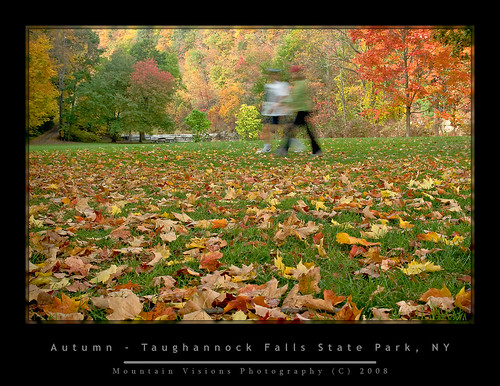
It occurred to me that despite autumn being my favorite time of the year that I never seem to make the most of it from a photography standpoint. Last year was so dry it seemed like the colors were not very bright or long lasting.
As of Columbus Day weekend 2008 I had absolutely nothing to show for what is so far a colorful autumn.
The high peaks in the Adirondacks are already well past peak as are the upper elevations of Vermont and NH. I had already seen some great images of the snow covered summits with colorful lower elevations and knew going south was better.
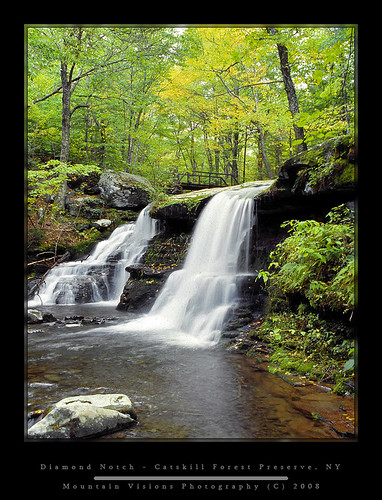
Leaf season peak foliage varies by elevation and localized climate (duh, but I just wanted to impress you with my common sense wisdom). Even two areas at the same elevation and latitude can differ if one is close to the water and the other inland, or has some other factor that influences local climate. Just like chasing spring wildflower season can last weeks if you do it right, foliage season can be mapped out to catch peak after peak.
As it turned out the Heidelberg’s and Catskills are currently at peak and generally always around Columbus Day weekend.
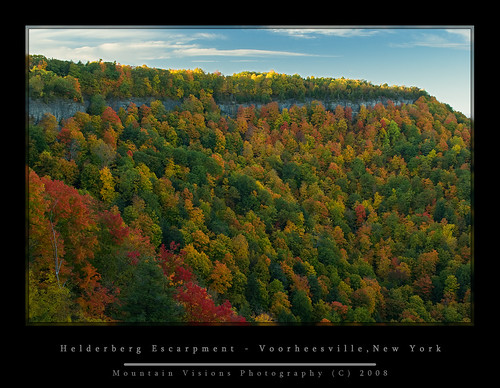
So Saturday afternoon we headed to Thacher State Park to hike the Indian Ladder trail. The trail is almost paved in many spots, and no special hiking attire is required to hike the approximately one mile loop. Actually, it is one of the few places you will find (attractive) women hiking in heels and mini skirts!!!
I had hiked the Indian Ladder once before on a dreary spring day and had the place to myself, but I had a feeling this trail was typically packed and devoid of any wilderness character. Sure enough it was, only making photography more difficult. Making things worse, the picturesque waterfalls I had photographed in my spring sojourn were almost totally dry.
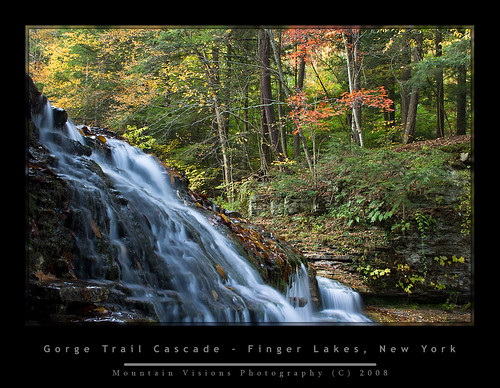
However, the near peak colors made up for the crowds and lack of water. I came away with a few nice shots and a nice hike only a short drive from home. I often fall into the same trap as everyone else by thinking I need to go someplace far away to capture great images, the truth is, you have a unique advantage when shooting close to home in creating the very best images, since you can time everything for optimal conditions.
Since Aim did not have off Monday, I needed to decide whether to do a day hike Sunday and Monday or go camping and save fuel, carbon emissions, and maximize shooting in an ideal setting. Aim did not seem too enthused about going to the West Canada lakes wilderness, which was near, or slightly past peak for a day hike, so I decided to go camping Sunday and Monday.
Checking the foliage report showed that the Catskills were at peak, and the Finger Lakes were near peak, with the Great Lakes regions not yet peaked.
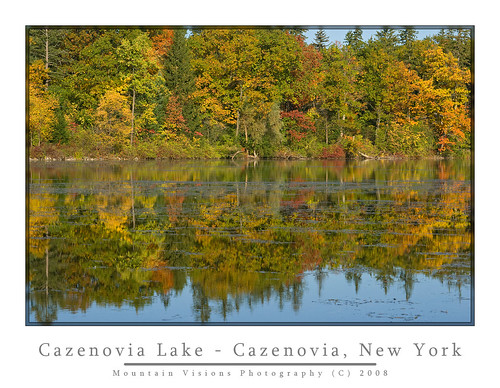
Having enjoyed, but spent so little time in the Finger Lakes over the years, I decided to go south and west and enjoy this different part of the state for a few days of off-season camping at Robert Treman State Park.
Treman, unlike the bulk of NYS Parks, and DEC campsites is opened past Columbus Day. Actually, Nov 30th! So it makes a great base camp for camping and foliage photography in what I consider one of New York States gems.
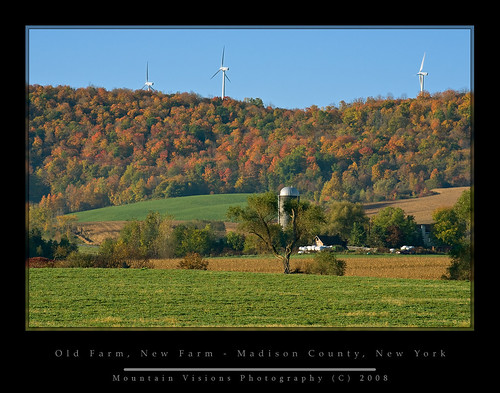
The Finger Lake region is obviously home to 5 of New York's largest lakes, but also it is home to New York’s largest wine region, and highest waterfalls. The area between this region and the Catskills is also some of New York’s most fertile farmland. New York is the #4 producer in the US of corn, and among the top in milk (#3), and apples (#2), cabbage (#3) and third in grape production. This region clearly shows the agricultural roots of NY. Fittingly, it is also home to New York’s (and perhaps the nations) best agricultural and veterinary school, Cornell University.
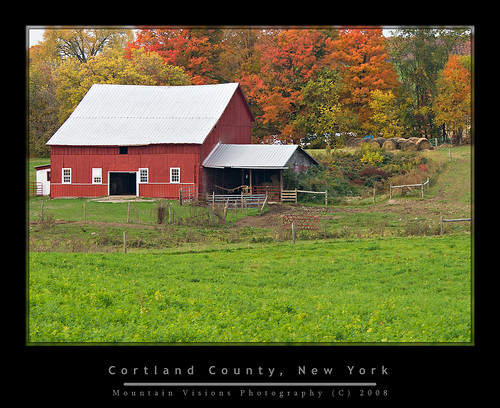
While if you’ve ever read any of my other trip reports you know my first love for a region of the diverse state of New York is the Adirondacks, but I’d be hard pressed to offer a better region as an example of New York than the Finger Lakes. To me the ruggedness, diversity, and refinement of the region are New York in a nutshell.
Robert H. Treman (there is also an Allan Treman a few miles north) is on the eastern edge of the Finger Lakes region, in the town of Ithaca. It is within 8 miles of 4 other state parks, and almost across the street from another equally beautiful park, Buttermilk Falls State Park.
I was actually surprised at the amount of people camping this weekend. There are 50+ sites at this park, and nearly all of them were filled. The last time we were here in September 2004, it was empty at the campground even though plenty of people were still out hiking on the trais.
The trails of these state parks are unique in themselves, they are aptly suited for those lacking either the fitness or desire to hike less civilized trails.
The trails of many of these Finger Lakes parks could actually be considered a history lesson of sorts, perhaps a great excuse for a teacher who loves to hike to organize a field trip ;-).
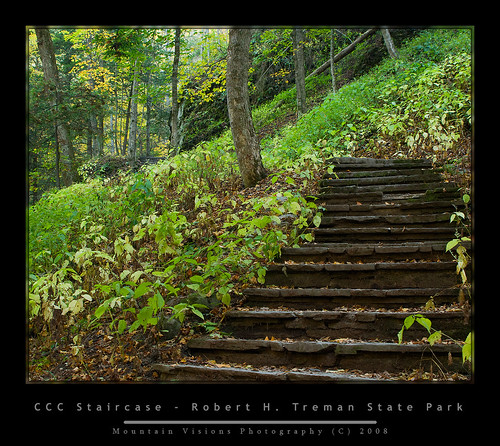
During the Great Depression, President Roosevelt started the CCC to put men to work doing something, even if most of the work that was done was essentially busy work. Still paying people to work rather than just giving them a check was better for the morale of a nation built on the puritan work ethic, and of course provided nearly of century of quality stonework that sees thousands of hikers a year.
A lot of the CCC work in the Finger Lakes is in need of serious repair, while other parts look brand new. Keeping in mind of course that this area sees a tremendous amount of water and temperature extremes resulting in many freeze/thaw cycles, that most of this stonework is still in great shape 80 years later.
Many of the Finger Lakes state park trails have a similar and sensible naming system which goes like this: above the gorge is called the “Rim Trail” and in the gorge is called the “Gorge Trail”.
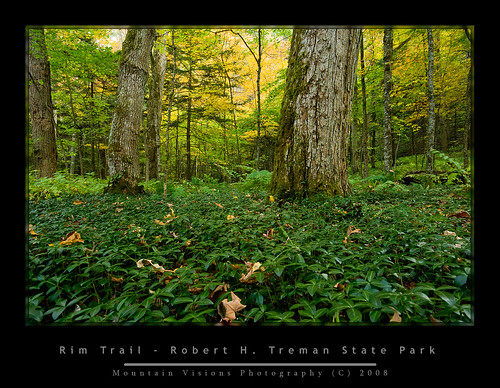
I hiked the 5 mile Rim/Gorge loop at Robert Treman, which goes to the top of Lucifer Falls, a cascade of over 112 feet. When you reach Lucifer Falls, the gorge is over 200ft deep. Along the trail, the gorge is filled with mosses, ferns, and in the warmer weather wildflowers. In the fall, the contrast of the changing leaves with the rich greens of the mosses and ferns can make for a spectacular contrast. The gorge is one waterfall or cascade after another, and honestly, if you dedicated yourself to shooting in the good light, you could spend years capturing the beauty found along this single 3-mile stretch. Although solitude and quiet contemplation you will not find during a weekend.
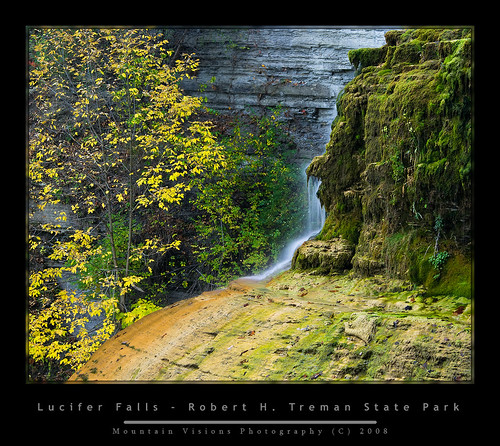
Monday, I woke up at 2:30am wide awake after hitting the sack at 8:30 the night before. I went back to sleep off and on till 5am when I decided to commit to the early start I had envisioned but expected not to make. It took me about 30 minutes to break down camp in the dark, and load up the Zuk.
The plan was to get to Taughannock Falls State Park, about eight miles away before sunrise, unfortunately while the plan worked, the sun didn’t cooperate. Instead of the brilliant blue skies we were forecast to have, it was a hazy light overcast. This soft diffuse lighting is great for macro shots and shooting water, but not great for foliage. I wanted the soft golden morning glow and Mother Nature didn't cooperate. I almost stayed on the shores of Cayuga Lake, to photograph what looked to be an interesting purple sunrise through the haze. But we’ve all seen enough sunrises, it’s foliage we want.
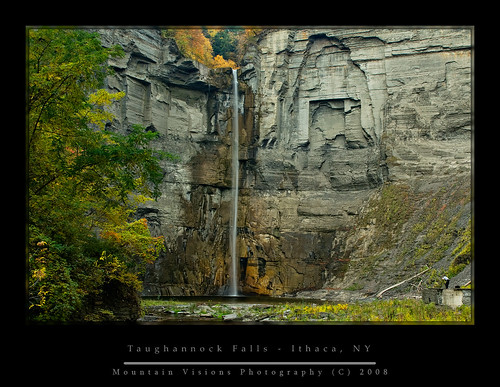
Once again, you have the Rim Trail and the Gorge Trail. The last time I was at this park Aim and I did the Rim trail to the falls overlook. My goal was this time around was to go to the base of the falls. I don’t remember the distance but I think it is about a mile to the base.
Taughannock Falls is actually New York's, and the eastern US highest waterfall. This of course can often be debated depending on how you rate the fall (there are longer cascades for instance), but Taughannock Falls is a single purely vertical drop that CANNOT be contested. No matter how you measure it, it’s going to work out to an equivalent of 215 vertical feet. How impressive is this? Well, Niagara Falls is a mere 182 feet high. Of course Niagara Falls claim to fame isn’t it’s height, or width but the sheer volume of water the that passes over the falls. Taughannock Falls by comparison is merely a trickle most of the year, and in summer nearly dries up.
The area below the falls would make an excellent swimming hole in summer, aside from the fact that these gorges are inherently unstable. Anyone lacking the intelligence to determine where the piles of rubble at the base of the gorge came from, just needs to stand around for a while and listen for the popping, cracking, and eventually falling of the rocks above. Suffice to say while wandering around off the trail I was a bit uneasy. Having been hit in the (helmeted) head plenty of times while rock climbing, I don't take rock fall lightly.
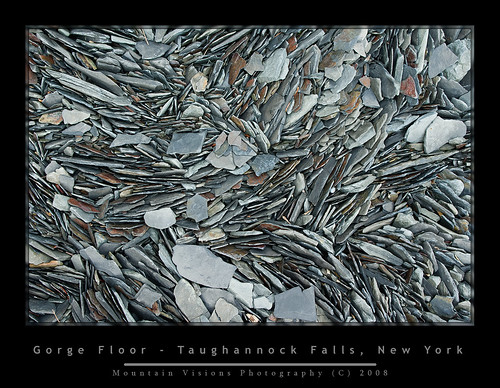
Disappointed with the morning light, I looked around for some shots that benefited from the soft low contrast light, but eventually just headed out after having the park to myself for a few hours.
Overall a nice beautiful weekend and a change of pace for me.






















